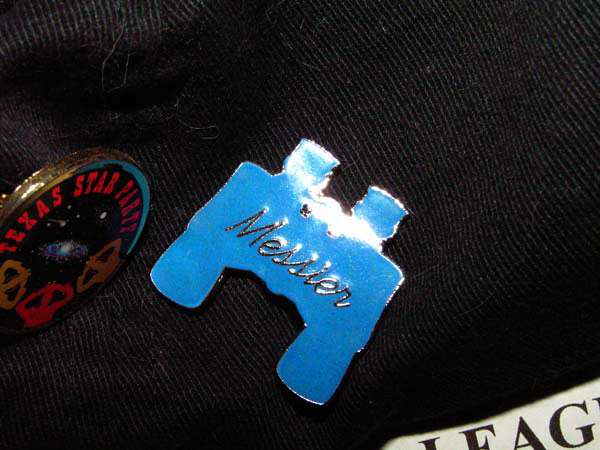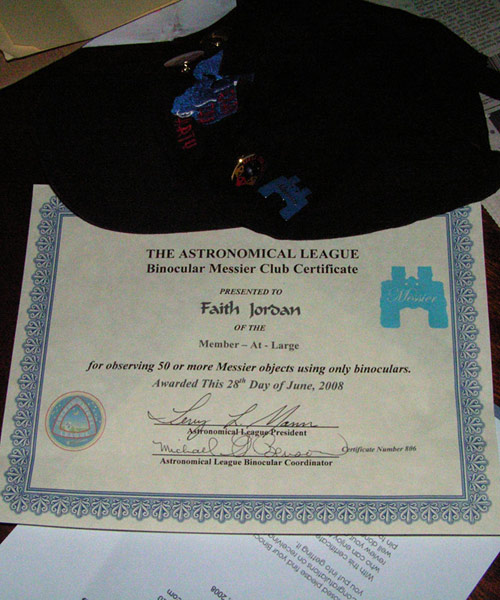
- AL Binocular Messier Pin
Finding the Messier objects with binoculars – successes and failures
Although I have been an active deep sky observer since 1993/94, I have actually never systematically looked for all of the Messier objects, instead observing them if they happened to be in the region of sky I was interested in on a given night. I had been without a scope for two years, having been forced to sell my 8-inch for financial reasons, so I decided to use my under-utilised (for astronomy that is) 8×42 binoculars for this. These binoculars are made by Leica and are, without question, the finest binoculars I have EVER used for anything – whether astronomy or birding.
Anyway, here are the Messier objects I have observed through my binoculars to date, beginning in Southampton in January 2005, continuing when I returned to the Isle of Wight in May 2005 and finishing at the Texas Star Party in June 2008. All observations, unless otherwise stated, were made from a dark rural site and, in every case, were made with the 8×42 binoculars. The reason for sticking with the 8x42s was that I wanted a consistent record of what I’d seen using just one instrument.
M1 Tau Faintly visible as barely discernible smudge.
M2 Aqr Visible as bright round patch just north of Beta Aquarii. Poor transparency and seeing, due to mist.
M3 CVn Round and obvious. Observed at 2006 Texas Star Party as part of TSP Binocular observing program
M4 Sco Easily seen with binoculars as round patch with brightening in centre.
M5 Ser Round and very bright. Obvious brightening in centre. Much brighter than M10 and M12, but same apparent size in binoculars.
M6 Sgr Beautiful open cluster near M7 and also very bright and easily resolved.
M7 Sgr Large, bright and obvious. The only object visible (except the moon) due to cloud. Easily resolved. Blue white stars.
M8 Sgr Lagoon Nebula. Easily visible to naked eye. Through binoculars appears as fuzzy elongated patch. Direct vision shows hint of nebula and the cluster. Averted vision shows more nebulosity M9 Oph Round, bright
M10 Oph Large, bright and obvious. Considerably brighter towards centre.
M11 Scu Easily picked up, despite murky conditions. Triangular fuzzy patch, bright and well defined. Looks cometary in binoculars.
M12 Oph Large – same apparent size as M10, but not quite as bright. More uniform in brightness than M10, although there appears to be some degree of condensation in core.
M13 Her Easily seen in binoculars. Bright, round, well defined against background sky from urban location. Looks condensed, but otherwise, no further detail.
M14 Oph Not that difficult. Round, even glow.
M15 Peg Found as dim round glow between, and slightly north of, Epsilon Pegasi and Delta and Gamma Equuleii. Hard to pick out against milky backround sky in poor transparency and seeing conditions.
M16 Ser Irregular glow
M17 Sgr Not that easy with binoculars – shows as a faint glow. Best detected using averted vision.
M19 Oph Round, brighter in centre
M20 Sgr Trifid Nebula. Just visible as faint round patch to north of M8.
M21 Sgr Bright knot of stars adjacent to M20.
M22 Sgr Very bright and obvious. Round, well defined and shows considerable condensation in the centre. with averted vision.
M24 Sgr Small Sagittarius Star Cloud. Very bright, very large and very obvious, both with naked eye and binoculars. M27 Vul Visible as irregular bluish glow. M28 Sgr Round, with brighter centre
M29 Cyg Reasonably bright and easy to find. Small hazy patch.
M31 And Easily found with the naked eye in good seeing, piece of cake in binoculars. Bright nucleus and spiral arms filling over half of binocular field. Absolutely spectacular.
M32 And Appears as fuzzy, small, round ‘blob’ close to M31 and just east of it. Looks like fat fuzzy star in 8x42s.
M33 Tri Easily found south of M31 as large, oval fuzzy patch. Very faint, low surface brightness. Poor seeing and transparency conditions.
M34 Per Glittering triangular patch NE of Algol (Beta Per). Several stars resolved with averted vision.
M35 Gem Easy naked eye object. Binoculars reveal an arrow head shaped cluster, glittering with resolved and unresolved stars. Also saw NGC 2158, IC 2157, NGC 2129, NGC 2175 and NGC 2169 in same f.o.v.
M36 Aur Large fuzzy patch (but smaller than M37). Not resolved
M37 Aur Large fuzzy patch, not resolved.
M38 Aur Large and fuzzy, some granulation. Bigger than M36 and M37.
M39 Cyg Glittering triangular patch N of Deneb. Several stars (about 10) resolved. Bright and obvious.
M40 UMa Two stars, big deal. Not sure how M. Messier could have possibly confused these with a comet.
M41 CMa Easily visible as glittering triangular patch SW of Sirius. Some stars resolved.
M42 Ori Easily visible to naked eye as well as binoculars. Bright and obvious. Nebulosity seen well, and stars associated with nebulosity. Trapezium visible from rural skies.
M43 Ori Visible only with averted vision. Pretty bright with a.v. Detached part of M42.
M44 Cnc Easily resolved into stars, all which are blue-white. Counted 22 through binocualrs and many more unresolved.
M45 Tau Easy, even from urban skies. Counted more than 7 stars from suburban Southampton. With 8×42 binoculars, it is full of blue star, too many to count properly. Made a reasonable sketch (to be uploaded later).
M46 Pup Large, round fuzzy patch. Not resolvable into stars.
M47 Pup Coarse, large and easily resolved.
M48 Hya Large, easily found with binoculars. Irregular shaped patch, misty-looking, with averted vision many stars resolved although retains overall misty look.
M50 Mon Visible as large, hazy patch a third of the way from Sirius to Procyon. M51 CVn After getting dark adapted, this galaxy is easily seen as faint round patch. M52 Cas Visible as nebulous patch. No stars resolved. Beta Cas points almost directly at it.
M53 Com Round, small, bright with denser middle.
M55 Sgr Bright and large.
M56 Cyg Easily picked up. Well defined round glow.
M57 Lyr Ring Nebula. Stellar looking, but fuzzy.
M62 Oph Bright, not perfectly round.
M63 CVn Between Alpha CVn and Alkaid (westernmost star in Bear’s tail). Fairly bright and easy. Elongated east-west. Large.
M64 Com Faint oval. Not that difficult
M65 Leo This and M66 are adjacent to each other and easily seen in the 8×42 binoculars. Bright and lying at an angle to each other, like rabbit ears. Oval. Both galaxies are as bright as each other.
M66 Leo As M65. M67 Cnc Visible as elongated misty patch SE of M44. Averted vision resolves some stars, including a prominent one in the northern part of the cluster
M68 Hya Faint, round, with brighter core
M69 Sgr Small, bright, even glow
M71 Sge Faint and hard to see.
M74 Psc Suspected. Very faint. Not entirely sure about this one. Definitely a hint of something fuzzy here.
M76 Per Possible but doubtful. Will have another go on a night less hampered by wind and cloud.
M78 Ori Very faint, hardly brighter than background sky.
M80 Sco Small, faint and round. Took a couple of minutes to become obvious.
M81 UMa Dim little oval, but not hard to spot. M82 UMa Dim elongated patch adjacent to M81.
M92 Her Smaller and brighter than M13. Round. Easy target for binoculars even from urban skies (as this was).
M94 CVn Faint oval patch between, and slightly to the north of, Alpha and Beta CVn
M95 Leo Dim, barely discernible – prob due to murky sky
M96 Leo Also dim and barely visible – prob due to murky sky
M97 UMa Owl Nebula. Faint but visible. Round glow. Observed from dark TSP skies.
M101 UMa Tough, but seen from TSP. Faint, elongated
M102 Dra ? = M101 observed earlier this year.
M103 Cas Fuzzy patch, slightly elongated north to south. Mostly nebulous looking, but a couple of stars – either associated or superimposed foreground – seen.
M105 Leo Faint. Barely visible, just south of 52 Leonis
M106 CVn Very faint. Elongated smudge.
M107 Oph Faint, round and hardly visible in the 8×42 binoculars. Smaller than M5, M10 and M12.
M108 UMa At last, from TSP 2008. Elongated, faint
M109 UMa As 108 – seen from dark skies of Texas Star Party 2008. Faint oval.
M110 And Visible with averted vision just west of M31. Faint elongated glow.
I finished off this project at the 2008 Texas Star Party, and I am certain that this is as far as I can go with the Messier Objects and small binoculars, although I would like to get a larger pair, such as 15×70 or 20×80 and do it again as I am sure I’d see a lot more and pick up all the Messiers. Since doing this project, I have now also finished the Astronomical League’s Deep Sky Binocular Program.
Nearly every beginner in astronomy thinks that he or she needs a telescope – as did I when I began observing nearly 20 years ago – but this is definitely not the case. Binoculars, even a small pair like a pair of 8x42s, are a profitable and enjoyable means of getting started and, indeed, carrying on. Okay, you are going to want a scope sooner or later particularly if, like me, you are an avid deep-sky observer wanting to see very faint objects or tiny galaxies, or if you are a planetary observer wanting to see detail on Mars or Jupiter, or the rings of Saturn, etc, but as the ultimate ‘grab and go’ observing tool for a quick session seeking out brighter deep sky objects, binoculars are hard to beat.

The Binocular Messier Certificate